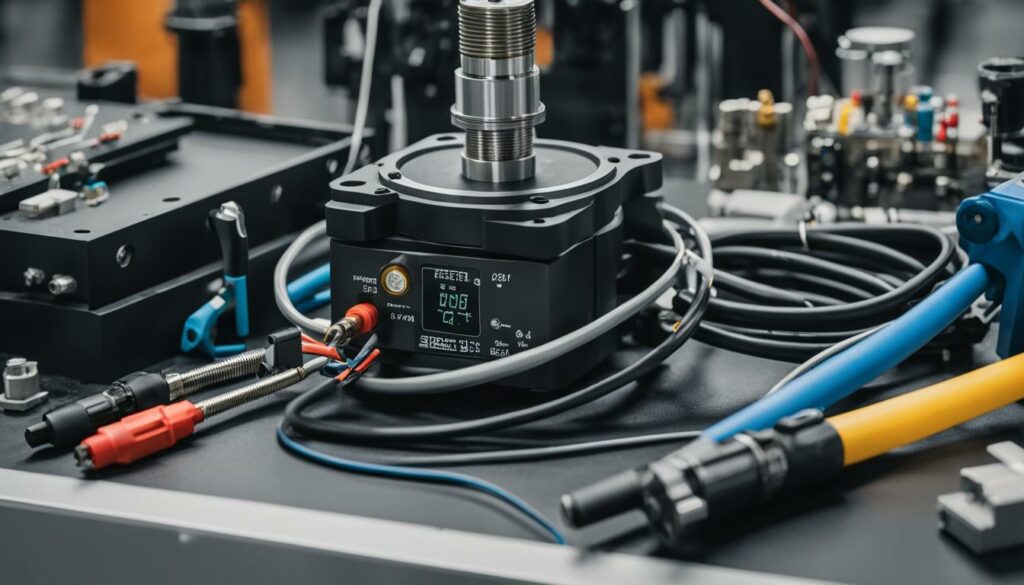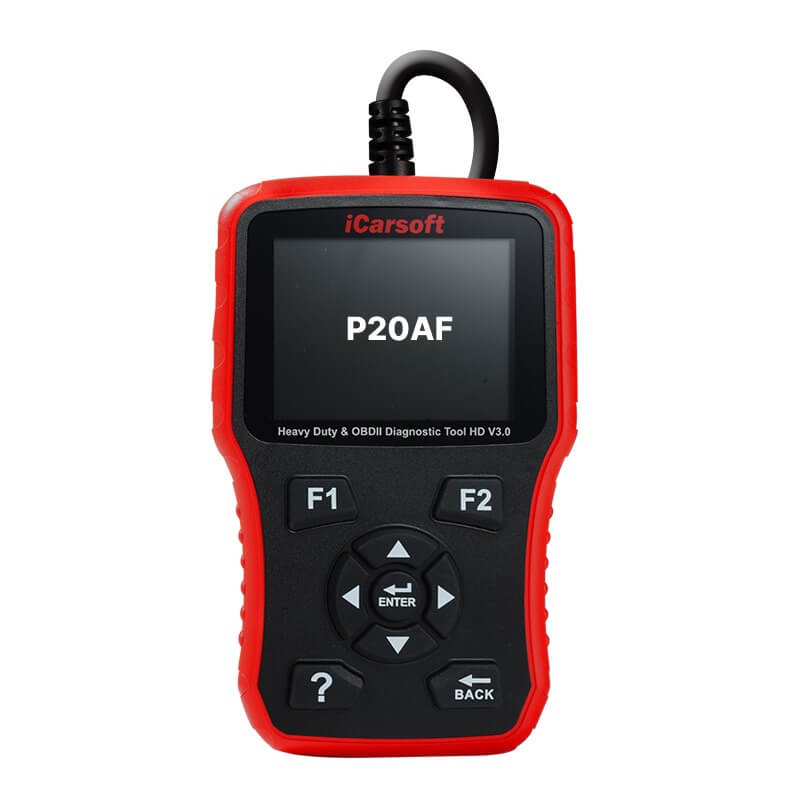P20AF – Reductant Pressure Insufficient For Delivery Range 1
POSTED IN pcodes
Welcome to our comprehensive guide on the P20AF error code. In this article, we will explore the causes, symptoms, diagnosis, and repair solutions for the P20AF error, which indicates reductant pressure insufficiency for delivery in Range 1. This error is commonly associated with the vehicle’s emissions control system, particularly the diesel exhaust fluid (DEF) system. Understanding and addressing this error is vital for maintaining proper vehicle performance and emissions compliance.
Receiving the P20AF error can be concerning, but fear not! We have all the information you need to navigate this issue effectively. From understanding the technical description and severity of the fault code to learning about the common symptoms and causes, we’ll guide you through each step of the process. Whether you’re a car enthusiast or a professional mechanic, this guide aims to provide valuable insights and solutions.
Key Takeaways:
- The P20AF error indicates reductant pressure insufficiency for delivery in Range 1
- It is commonly associated with the vehicle’s emissions control system and the DEF system
- The error can result in decreased vehicle performance and potential engine damage
- Professional assistance for diagnostics and repair is recommended
- Maintaining regular maintenance and following preventive measures can help prevent the error
Understanding P20AF Fault Code
When your vehicle’s diagnostics system displays the P20AF fault code, it indicates that the reductant pressure in Range 1 is below the required level for proper delivery. This technical description represents a potential issue with the reductant pressure in your vehicle’s emission control system. While it may not directly impact the vehicle’s overall performance, it can lead to inadequate operation of the diesel exhaust fluid (DEF) system and affect the vehicle’s emissions control capabilities.
The severity of the P20AF fault code can vary depending on the underlying cause and the extent of the pressure insufficiency. It is crucial to address this issue promptly to prevent any adverse effects on the vehicle’s emissions and potential damage to the engine.
“The P20AF fault code represents a reductant pressure error in Range 1, which can impact the vehicle’s emissions control system. Promptly addressing this issue is essential to prevent increased emissions and potential engine damage.”
Buy tested tuning file for Adblue / EGR / DPF / Adblue off now!
Register Now or Already have an account, Login now
To ensure a clear understanding of the fault code, let’s take a closer look at the meaning and potential implications:
Technical Description
The P20AF fault code relates to the reductant pressure sensor in your vehicle’s emissions control system, specifically referring to insufficient pressure for delivery in Range 1. The reductant pressure sensor monitors the pressure of the DEF system, which helps regulate emissions and ensure compliance with environmental regulations.
Meaning and Implications
When the reductant pressure in Range 1 falls below the required level, it can hinder the proper delivery of DEF and result in decreased emissions control efficiency. As a result, the vehicle may produce higher levels of harmful emissions, impacting both environmental sustainability and compliance with emissions regulations.
Furthermore, the P20AF fault code can indicate potential issues within the reductant delivery system, potentially affecting other components such as the DEF pump, injector, or supply lines.
Severity
The severity of the P20AF fault code depends on multiple factors, including the extent of the pressure insufficiency and the vehicle’s specific emission control system. While the immediate impact on vehicle performance may be minimal, prolonged exposure to inadequate reductant pressure can result in increased emissions and potentially lead to engine damage.
To gain a better understanding of the potential severity of the fault code, it’s essential to diagnose and repair the underlying cause promptly.
In the next section, we will explore the common symptoms associated with the P20AF fault code and provide insight into how to identify if your vehicle is affected by this issue.
Symptoms of P20AF Error
In cases of a P20AF error, there are several symptoms that vehicle owners may encounter. These symptoms serve as indications that there may be an issue with the reductant delivery system and reductant pressure sensor.
- Illumination of the check engine light: When the P20AF error occurs, the check engine light, also known as the malfunction indicator lamp (MIL), typically illuminates on the vehicle’s dashboard. This serves as a warning sign that there is a problem within the emissions control system.
- Decrease in vehicle performance: Another common symptom of the P20AF error is a noticeable decrease in vehicle performance. Owners may experience a lack of power, reduced acceleration, or overall poor engine operation. This can impact the drivability and efficiency of the vehicle.
- Inaccurate readings from the reductant pressure sensor: The reductant pressure sensor plays a crucial role in the proper functioning of the reductant delivery system. In the case of a P20AF error, the reductant pressure sensor may fail to provide accurate readings. This can result in further complications within the reductant delivery system, exacerbating the issue at hand.
If any of these symptoms are detected, it is highly recommended to have the vehicle promptly diagnosed by a professional technician. By identifying the exact cause of the error, appropriate repairs or replacements can be carried out to restore the vehicle’s performance and ensure efficient operation of the reductant delivery system.

| Symptoms of P20AF Error |
|---|
| Illumination of the check engine light (MIL) |
| Decrease in vehicle performance |
| Inaccurate readings from the reductant pressure sensor |
Common Causes of P20AF Error
The P20AF error, signaling reductant pressure insufficiency for delivery in Range 1, can stem from various causes. Understanding these common triggers is essential for effective troubleshooting and resolution. The following are the primary factors that can contribute to the P20AF error:
| Cause | Description |
|---|---|
| Faulty Reductant Pressure Sensor | The reductant pressure sensor plays a crucial role in measuring and regulating the pressure within the DEF system. Any malfunction or inaccurate readings from the sensor can result in the P20AF error. |
| Malfunctioning Reductant Pump | The reductant pump is responsible for supplying the DEF (diesel exhaust fluid) to the emissions control system. A malfunctioning pump can result in insufficient pressure, leading to the P20AF error. |
| Clogged or Restricted DEF Injector | If the DEF injector becomes clogged or restricted, it can affect the proper delivery of the DEF, causing a drop in reductant pressure and triggering the P20AF error. |
| Issues with DEF Tank or Supply Lines | Problems with the DEF tank, such as contamination, leaks, or inadequate fluid level, as well as issues with the supply lines, can disrupt the flow of DEF and result in insufficient reductant pressure for delivery. These can contribute to the P20AF error. |
When troubleshooting the P20AF error, it is crucial to inspect and test these components to identify the specific cause accurately. By addressing the underlying issue, you can effectively resolve the error and restore optimal performance to the vehicle’s emissions control system.
Diagnostic and Repair Solutions
When facing the P20AF error, it is crucial to seek professional assistance for accurate diagnostics and effective repair solutions. A qualified technician will have the expertise and specialized equipment necessary to analyze the reductant pressure system and identify the exact cause of the error.
Through thorough diagnostics, the technician can pinpoint issues such as a faulty reductant pressure sensor, a malfunctioning reductant pump, a clogged or restricted DEF injector, or problems with the DEF tank or supply lines. Once the root cause is determined, the technician can perform the necessary repairs or component replacements to resolve the P20AF error.
In cases where professional assistance is unavailable, there may be alternative solutions available. One option involves uploading the Engine Control Unit (ECU) file to a trusted portal, which can facilitate the permanent removal of the P20AF error.
Benefits of Professional Assistance:
- Accurate diagnostics: Qualified technicians use specialized equipment to accurately identify the cause of the P20AF error, ensuring targeted repairs.
- Expert knowledge: Professionals have in-depth knowledge of reductant pressure systems, allowing for efficient troubleshooting and repair.
- Component reliability: Repairs made by professionals typically utilize genuine parts to ensure the longevity and reliability of the vehicle’s reductant pressure system.
- Comprehensive service: Seeking professional assistance ensures a thorough inspection of the entire reductant pressure system, addressing any additional potential issues.
It is important to note that attempting DIY repairs without proper knowledge and expertise may result in further damage or ineffective solutions. Therefore, it is highly recommended to rely on qualified professionals for diagnostic and repair processes related to the P20AF error.

| Diagnostic and Repair Solutions | Benefits |
|---|---|
| Seek professional assistance |
|
| Alternative solutions | Permanent removal of P20AF error by uploading ECU file to trusted portal |
Importance of Addressing P20AF Error
The P20AF error, specifically indicating a reductant pressure error in the vehicle’s emissions control system, should be addressed promptly to ensure the proper functioning of the vehicle and compliance with emissions regulations. Failing to resolve this issue can lead to increased emissions and potential damage to the engine, compromising both performance and environmental impact.
Resolving the P20AF error is crucial for maintaining the effectiveness of the emissions control system. By addressing the error, you can mitigate the risk of exceeding emission limits and avoid potential issues during vehicle inspections or emissions testing.
Properly functioning emissions control systems play a vital role in reducing harmful pollutants released into the environment. By promptly addressing the P20AF error, you contribute to preserving air quality and minimizing the ecological impact of vehicle emissions.
“Addressing the P20AF error is not only essential for the vehicle’s performance and compliance but also for the overall well-being of our environment.”
Therefore, it is recommended to seek professional assistance for accurate diagnostics and repair solutions when dealing with the P20AF error. A qualified technician can utilize specialized equipment and expertise to identify the root cause of the reductant pressure error and perform the necessary repairs or component replacements.
Alternatively, if professional assistance is unavailable, there may be alternative solutions available, such as permanent removal of the error through uploading the Engine Control Unit (ECU) file to a trusted portal. However, it is crucial to exercise caution and consult experts to ensure the appropriateness and legality of such solutions.
Addressing the P20AF error not only ensures the proper functioning of the emissions control system but also demonstrates your commitment to a cleaner and healthier environment.
Preventive Measures for P20AF Error
To minimize the likelihood of encountering the P20AF error, regular maintenance of the DEF system is essential. By implementing the following preventive measures, you can ensure the smooth operation of your vehicle and reduce the risk of reductant pressure errors:
- Check DEF tank level:
- Ensure proper DEF fluid quality and purity:
- Inspect DEF supply lines for leaks or restrictions:
- Monitor reductant pressure sensor readings:
- Follow the manufacturer’s recommended maintenance schedule:
- Use high-quality DEF fluid:
Regularly checking the DEF tank level will help you gauge the amount of reductant available for emission control. Ensuring proper DEF fluid quality and purity is crucial, as contaminated or degraded fluid can impact the effectiveness of the DEF system. Regular inspections of the DEF supply lines will help identify any leaks or obstructions that could hinder reductant delivery. Monitoring the reductant pressure sensor readings will provide valuable insights into the performance of the DEF system. Following the manufacturer’s recommended maintenance schedule is essential for keeping your DEF system in optimal condition. Using high-quality DEF fluid will help prevent potential issues related to reductant impurities or inefficiencies.
By incorporating these preventive measures into your vehicle maintenance routine, you can avoid the P20AF error and ensure the optimal performance of your DEF system.
Conclusion
The P20AF error, indicating reductant pressure insufficiency for delivery in Range 1, can have a significant impact on the vehicle’s emissions control system. It is crucial to promptly diagnose and address this issue to ensure proper vehicle performance and compliance with emissions regulations.
Seeking professional assistance for diagnostics and repairs is highly recommended to accurately identify the cause of the error and implement appropriate solutions. However, alternative options such as permanent removal of the error may also be available, although caution should be exercised before considering such measures.
Regular maintenance and following preventive measures can play a crucial role in preventing the occurrence of the P20AF error. It is important to prioritize the maintenance of the DEF system, including checking the DEF tank level, ensuring DEF fluid quality and purity, inspecting the DEF supply lines, and monitoring reductant pressure sensor readings.
By taking proactive steps to address and prevent the P20AF error, vehicle owners can ensure optimal performance, maintain compliance with emissions regulations, and minimize the risk of potential issues during inspections or emissions testing.
FAQ
What does the P20AF fault code indicate?
The P20AF fault code indicates a reductant pressure error in the vehicle’s emissions control system. Specifically, it refers to the reductant pressure being insufficient for delivery in Range 1.
What are the symptoms of the P20AF error?
Common symptoms of the P20AF error include the illumination of the check engine light and a decrease in vehicle performance. The reductant pressure sensor may also fail to provide accurate readings.
What are the common causes of the P20AF error?
The P20AF error can be caused by a faulty reductant pressure sensor, a malfunctioning reductant pump, a clogged or restricted DEF injector, or issues with the DEF tank or supply lines.
What should I do if I encounter the P20AF error?
It is recommended to seek professional assistance for accurate diagnostics and repair solutions. A qualified technician can analyze the reductant pressure system, identify the cause of the error, and perform the necessary repairs or component replacements.
Why is it important to address the P20AF error?
Addressing the P20AF error promptly is crucial to ensure the proper functioning of the vehicle’s emissions control system. Failure to resolve this issue can lead to increased emissions and potential damage to the engine.
What are some preventive measures for the P20AF error?
To minimize the likelihood of encountering the P20AF error, regular maintenance of the DEF system is essential. This includes checking the DEF tank level, ensuring proper DEF fluid quality and purity, inspecting the DEF supply lines for leaks or restrictions, and monitoring the reductant pressure sensor readings.


